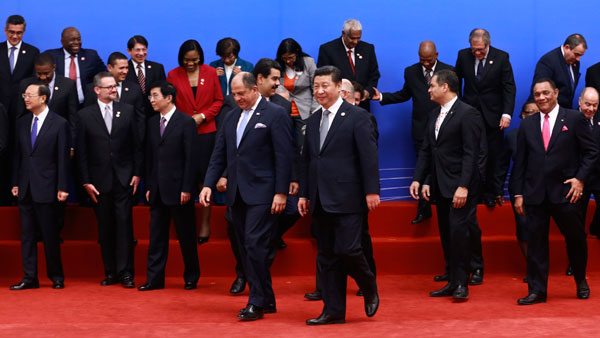A South-South cooperation framework
By Gina Caballero (China Daily) Updated: 2015-01-09 09:59
 |
|
President Xi Jinping and guests attend a photo session during the opening ceremony of the first Ministerial Meeting between China and the Community of Latin American and Caribbean States. FENG YONGBIN / CHINA DAILY |
The opening of the China-CELAC Forum (CELAC is the abbreviation of Community of Latin America and Caribbean States) in Beijing follows the intense activity the two sides have had over the past years.
President Xi Jinping has visited the region twice in two years. During his last visit in July 2014, he attended the China-Latin America and the Caribbean Leaders Summit in Brasilia, Brazil, where the establishment of the forum was announced. More than 11 heads of state of Latin American countries have visited China during the same period. And high-ranking officials and scholars from different institutions in China and CELAC have exchanged visits to promote and smoothen dialogue.
The forum in Beijing this week, which will bring together the presidents of Cuba, Ecuador, Costa Rica and Bahamas, and foreign ministers and other high-level officials from China and CELAC countries, will undoubtedly be a milestone in China-CELAC relations. It comes after a dynamic decade of trade and economic relations; two-way trade jumped from $12 billion in 2000 to $261.75 billion in 2013.
Also, according to estimates by the UN Economic Commission for Latin America and the Caribbean, China with its share of the region's exports at 10 percent and imports at 16 percent was set to replace the European Union as the second-largest trading partner of Latin America in 2014. Thanks to this market drive, China and the region have bridged the enormous knowledge gap they had since they started interacting in earnest in 2000.
But despite that, China and Latin America and the Caribbean still face serious limitations in mutual understanding, which could thwart their efforts to address the structural challenges their economic interactions have been encountering - such as the over-concentration of the region's exports on a small number of commodities. According to United Nations COMTRADE, 73 percent of the region's exports to China in 2013 were made up of commodities, while for the world they added up to 41 percent. And although Chinese foreign direct investment in CELAC has been growing significantly since 2010, at roughly $9-10 billion a year, it is still in its initial stages and concentrated again on natural resources.

I’ve lived in China for quite a considerable time including my graduate school years, travelled and worked in a few cities and still choose my destination taking into consideration the density of smog or PM2.5 particulate matter in the region.











